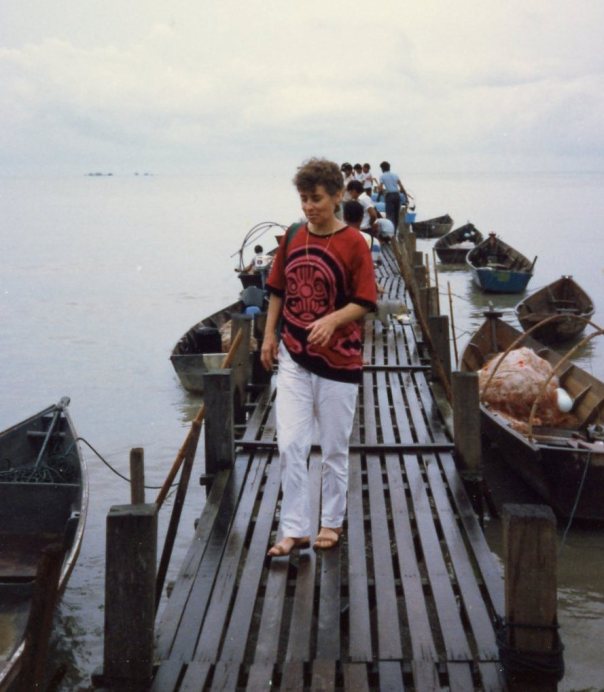MELAKA, MALAYSIA
This was going to be a post about the difficulty of getting an Indian visa and going to Sri Lanka instead. And it included this photo because it is my beautiful boys and me returning my our sojourn in the Philippines. I’m leaving the photo HOWEVER now this post is about Marsha and Robert and me in MELAKA, MALAYSIA.
MELAKA, MALAYSIA AND HISTORY CLASS
Let’s talk about Melaka, Malaysia. And history classes.
I did not initially love history. High school history was taught by a big gruff and grumpy Native guy from Red Lake Indian Reservation who was first and foremost the football coach, and who didn’t like his own or anyone else’s history. I get that, and I’m sure it didn’t improve his mood to be coaching a team named the Northome Warriors, but it did not make me want to grow up and become a historian.
By the time I took a first college class in world history and fell in history-love, I had lived in the north, south and east of the U.S., the Philippines and was temporarily settled in North Carolina. Which is to say I had seen very little of the world but I had crossed that first ocean.
The question is—did even that limited amount of travel make me more receptive to studying world history OR did mom’s old geography book (of which I’ve often written) set off the spark that inspired me to marry an Air Force guy because I thought that might get me everywhere in the world?
History, travel; travel, history? Chicken or egg?
Now it is 2013. After many years of reading general histories AND after 90 different passport stamps, I am starting it all again. I’ve signed up for Coursera’s “History of the World since 1300,” a Princeton University class. Back to school and in the Ivy League no less!
Will I enjoy this history class even more than others in the past because I have the experience of having been more places in the world? Or has traveling the globe made me want to understand more of its history? The chicken and egg question again.
I do see this textbook and class as background for my personal travels and as an excuse to share small stories about small adventures in my life.
Melaka, Malaysia. My textbook calls it the Crossroads of Afro-Eurasia and says: Because of its strategic location and proximity to Malayan tropical produce, Melaka became a key cosmopolitan city. Indian, Javanese, and Chinese merchants and sailors spent months at a time in such ports selling their goods, purchasing return cargo, and waiting for the winds to change so they could reach their next destination. During peak season, Southeast Asian ports teemed with colorfully dressed foreign sailors, local Javanese artisans who produced finely textured batik handicrafts (using melted wax applied to cloth before dipping it into blue and brown dyes), and money-grubbing traders. The latter converged from all over Asia to flood the markets with their merchandise and to search for pungent herbs, aromatic spices, and agrarian staples such as quick-ripening strains of rice to ship out. In a sense, each bustling port represented the cosmopolitan mosaic that Southeast Asia had become. (“Worlds Together, Worlds Apart: Volume Two, From 10000 CE to the Present,” p. 369)
I was in Melaka in 1987with my brother and sister-in-law on our way from Java, going through Singapore and Malaysia to Bangkok. We spent two nights there and, while I can’t report any flings with ‘colorfully dressed foreign sailors,’ I did return with a blue and brown batik shirt! What I remember is this: Melaka is a historically, visually, atmospherically striking World Heritage site, full of fine rose-colored buildings, glossy-leaved twisty-trunked banyan trees, boats/nets/fisherman and their catches jamming the harbors, and the scent of durian and overripe fish heads (similar) and a potpourri of tropical blooms. Our Chinese-owned hotel (Lonely Planet budget category) locked us in at night because the Malays and Chinese were fighting—as they undoubtedly were doing in 1300 and are still doing in 2013—and there were nighttime raids and attacks. The hotel was accommodating in all other matters. Upon arrival we mentioned we were hungry. No problem. Someone quickly pulled a table out from behind the souvenir shirt racks, ran next door for bowls of fried rice and bottles of local beer and we dined by the trinket tables as shoppers drifted by.
Our second night was even more interesting. A Portuguese (Melaka’s colonial masters) outdoor restaurant was recommended—but it rained. Not a problem. They sat us at a table under the monster banyan tree, and proceeded to bring us platter after platter of various fruits of the sea. It’s all a delicious haze as the rain came down harder and harder and Robert and I got drunk and the in-house band played and sang “Born in the USA” innumerable times with thunder and lightning joining in the chorus.
Today, 1987 seems about as far away as the twelfth century. Isn’t it excellent that we have journals and cameras and blogs AND history books to maintain connections?







Reblogged this on Stories.